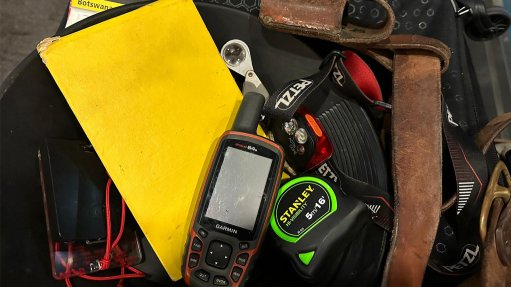
Field equipment of Kavango COO Brett Grist, who was dispatched to Ditau in Botswana at the last minute to supervise and confirm the gold discovery.
Botswana-focused base and precious metals explorer Kavango Resources has commissioned professor and former Department of Geology at Brandon University in Canada chairperson Dr Hamid Mumin to undertake a review of the mineral exploration potential of its Ditau project, as well as sent a senior manager to the country to supervise and confirm the discovery.
The review has identified a possible high-potential banded iron formation- (BIF-) hosted lode gold model at the Ditau project, and follows Kavango previously recognising a 100-m-thick zone of interest from 293 m to 393 m, in drill hole DITDD004 at Ditau.
This find is further strengthened by assay results confirming the presence of a gold mineralising system in the zone, with a peak grade of 0.175 ppm over 2 m from 312 m to 314 m.
As a result of findings in the zone of interest, Kavango dispatched COO Brett Grist – with significant gold exploration experience gained in Australia, Mali, Ghana and the Democratic Republic of Congo – on a last-minute trip on March 6 to visit the prospect and oversee the relogging and resampling of core from DITDD004.
Mumin assessed drill logs, core photography and assays from DITDD004, identifying the likely presence of a large alteration system within a thick BIF that he considers exhibits “excellent” gold potential.
He recommends that the BIF-hosted lode gold deposit model needs to be investigated seriously, subject to his review of physical drill cores.
“This is a new and very exciting opportunity for Kavango,” says Mumin.
He explains that iron formations are important in the formation of world-class lode gold deposits because the presence of abundant iron “forms a type of chemical trap for gold”.
Kavango executive directors Grist and Jeremy Brett say Mumin’s report represents a “significant potential breakthrough” for Kavango on the Ditau project.
“We did not find carbonatites as we had intended, but we are certainly delighted with the potential for a large BIF-hosted lode gold system. Such systems can be capable of hosting a multimillion-ounce gold deposit,” they say.
Encouragingly, Grist and Brett say the BIF encountered in hole DITDD004 occur from 293 m to end of hole at 393 m. “This is a very wide intersection that is open at depth.”
The BIF intersected by DITDD004 is more than 100 m and open at depth.
The intersecting structure, which is the source of fracturing, brecciation, sulphidisation, gold, silver, copper and arsenic, appears also to be large. These factors combined could, in Mumin’s opinion, have led to a significant gold mineralising event.
He adds that, as a result of the overall robustness of the current discovery, the chances of finding economic grades in the Ditau discovery area are “very good”.
The Ditau project – where Kavango is prospecting for rare earth elements, iron-ore, copper and gold – covers 759.3 km2 in south Botswana, where geophysical analysis has identified 12 geophysical structures.
Going forward, drill core samples and thin sections from work previously carried out at Ditau have been couriered to Mumin for him to verify his proposed exploration model.
In addition to this, and under the direction of Mumin, about 200 additional assays are being undertaken, focussed on the gold- and silver-bearing intervals, using non-destructive neutron activation analysis.
Also, up to 24 samples are being sent from Botswana to Canada for additional petrology work, to complement those already completed by Petrolab in 2022.
Kavango has also applied for additional licence areas adjacent to the Ditau property, to secure ground that could also be relevant to this new ore deposit model.